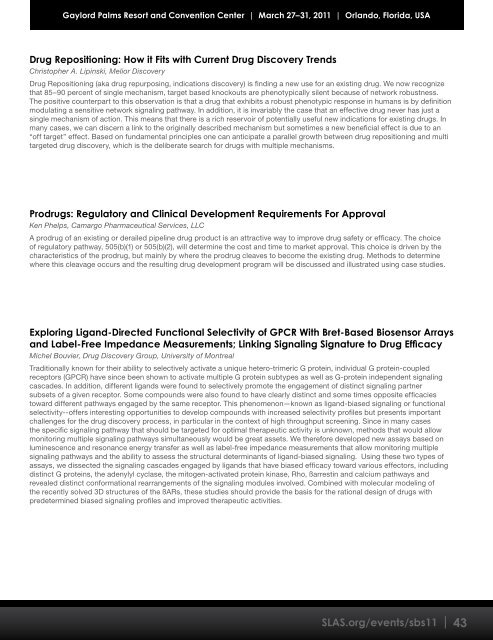You also want an ePaper? Increase the reach of your titles
YUMPU automatically turns print PDFs into web optimized ePapers that Google loves.
Gaylord Palms Resort and Convention Center | March 27–31, <strong>2011</strong> | Orlando, Florida, USA<br />
Drug Repositioning: How it Fits with Current Drug Discovery Trends<br />
Chris<strong>to</strong>pher A. Lipinski, Melior Discovery<br />
Drug Repositioning (aka drug repurposing, indications discovery) is finding a new use for an existing drug. We now recognize<br />
that 85–90 percent of single mechanism, target based knockouts are phenotypically silent because of network robustness.<br />
The positive counterpart <strong>to</strong> this observation is that a drug that exhibits a robust phenotypic response in humans is by definition<br />
modulating a sensitive network signaling pathway. In addition, it is invariably the case that an effective drug never has just a<br />
single mechanism of action. This means that there is a rich reservoir of potentially useful new indications for existing drugs. In<br />
many cases, we can discern a link <strong>to</strong> the originally described mechanism but sometimes a new beneficial effect is due <strong>to</strong> an<br />
“off target” effect. Based on fundamental principles one can anticipate a parallel growth between drug repositioning and multi<br />
targeted drug discovery, which is the deliberate search for drugs with multiple mechanisms.<br />
Prodrugs: Regula<strong>to</strong>ry and Clinical Development Requirements For Approval<br />
Ken Phelps, Camargo Pharmaceutical Services, LLC<br />
A prodrug of an existing or derailed pipeline drug product is an attractive way <strong>to</strong> improve drug safety or efficacy. The choice<br />
of regula<strong>to</strong>ry pathway, 505(b)(1) or 505(b)(2), will determine the cost and time <strong>to</strong> market approval. This choice is driven by the<br />
characteristics of the prodrug, but mainly by where the prodrug cleaves <strong>to</strong> become the existing drug. Methods <strong>to</strong> determine<br />
where this cleavage occurs and the resulting drug development program will be discussed and illustrated using case studies.<br />
Exploring Ligand-Directed Functional Selectivity of GPCR With Bret-Based Biosensor Arrays<br />
and Label-Free Impedance Measurements; Linking Signaling Signature <strong>to</strong> Drug Efficacy<br />
Michel Bouvier, Drug Discovery Group, University of Montreal<br />
Traditionally known for their ability <strong>to</strong> selectively activate a unique hetero-trimeric G protein, individual G protein-coupled<br />
recep<strong>to</strong>rs (GPCR) have since been shown <strong>to</strong> activate multiple G protein subtypes as well as G-protein independent signaling<br />
cascades. In addition, different ligands were found <strong>to</strong> selectively promote the engagement of distinct signaling partner<br />
subsets of a given recep<strong>to</strong>r. Some compounds were also found <strong>to</strong> have clearly distinct and some times opposite efficacies<br />
<strong>to</strong>ward different pathways engaged by the same recep<strong>to</strong>r. This phenomenon—known as ligand-biased signaling or functional<br />
selectivity--offers interesting opportunities <strong>to</strong> develop compounds with increased selectivity profiles but presents important<br />
challenges for the drug discovery process, in particular in the context of high throughput screening. Since in many cases<br />
the specific signaling pathway that should be targeted for optimal therapeutic activity is unknown, methods that would allow<br />
moni<strong>to</strong>ring multiple signaling pathways simultaneously would be great assets. We therefore developed new assays based on<br />
luminescence and resonance energy transfer as well as label-free impedance measurements that allow moni<strong>to</strong>ring multiple<br />
signaling pathways and the ability <strong>to</strong> assess the structural determinants of ligand-biased signaling. Using these two types of<br />
assays, we dissected the signaling cascades engaged by ligands that have biased efficacy <strong>to</strong>ward various effec<strong>to</strong>rs, including<br />
distinct G proteins, the adenylyl cyclase, the mi<strong>to</strong>gen-activated protein kinase, Rho, ßarrestin and calcium pathways and<br />
revealed distinct conformational rearrangements of the signaling modules involved. Combined with molecular modeling of<br />
the recently solved 3D structures of the ßARs, these studies should provide the basis for the rational design of drugs with<br />
predetermined biased signaling profiles and improved therapeutic activities.<br />
<strong>SLAS</strong>.org/events/sbs11 | 43

















